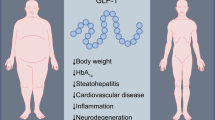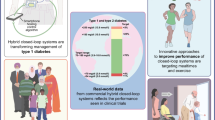Abstract
Gold-labeled insulin is bound first of all to the cilia of the oral field of Tetrahymena. A primary treatment (hormonal imprinting) with insulin increases the binding capacity even after 24h and makes it more sensitive for appearance a week later, within a minute of giving insulin-gold. The food vacuoles contain insulin-gold in pretreated cells or without pretreatment as well, though in imprinted situations the label can be found in pinocytotic vesicles at the bases of cilia in the oral field. Altogether, a functional difference can be observed between the cilia of the oral and non-oral surfaces of Tetrahymena and hormonal imprinting has a specifying effect on the binding of labeled hormone.
Similar content being viewed by others
References
Csaba, G. (1980) Phylogeny and ontogeny of hormone receptors: the selection theory of receptor formation and hormonal imprinting.Biol. Rev. 55:47–63.
Csaba, G. (1986) Why do hormone receptors arise?Experientia 42:715–718.
Csaba, G. (1985) The unicellular Tetrahymena as a model cell for receptor research.Int. Rev. Cytol. 95:327–377.
Csaba, G. (1990) Presence and Development of Hormone Receptors in Unicellular Organisms. In:Progress in Comparative Endocrinology (eds.: A. Epple, C. G. Scanes, M. H. Stetson), Wiley-Liss New York, Toronto, pp. 16–126.
Csaba, G. (1994) Phylogeny and ontogeny of chemical signaling. The origin and development of hormone receptors.Int. Rev. Cytol. 155:1–48.
Csaba, G. and Kovács, P. (1982) Histamine lectin and insulin-lectin binding site overlaps in Tetrahymena.Cell. Mol. Biol. 28:153–158.
Csaba, G. and Kohidai, L. (1986) Modelling the insulin receptor in the Tetrahymena. Time-dependence of receptor formation, down regulation and imprinting.Acta Protozool. 25:331–338.
Csaba, G. and Madarász, B. (1979) Localization of concanavalin-A binding sites in Tetrahymena by scanning electron microscopy.Experientia 35:1181–1182.
Csaba, G., Madarász, B. and Bohdaneczky, E. (1987) Internalization of receptor and hormone after hormonal imprinting, as detected with colloidal gold labelled insulin in cultures of a permanent liver cell line.J. Submicrosc. Cytol. 19:11–18.
Frens, G. (1973) Controlled nucleation for the regulation of the particle size in monodisperse gold solutions.Nature Phys. Sci. 241:20–22.
Fülöp, A. K. and Csaba, G. (1990) Effect of insulin, prednisolone and diiodothyronine on3H-uridine intake and localization on Tetrahymena.Acta Morph. Hung. 38:7–16.
Fülöp, A. K. and Csaba, G. (1990) Effect of insulin imprinting on the3H-amino acid uptake of the Tetrahymena.Acta Physiol. Hung. 75:261–267.
Hufnagel, L. A. (1992) Cortical ultrastructure and chemoreception in ciliated protists (Ciliophora).Microsc. Res. Techn. 22:225–264.
Kovács, P., Csaba, G. and László, V. (1984). Study of imprinting and overlap of insulin and concanavalin-A at the receptor level in a protozoan (Tetrahymena) model system.Acta Physiol. Hung. 64:57–63.
Kovács, P. and Csaba, G. (1990) Evidence of the receptor nature of the binding sites induced in Tetrahymena by insulin treatment. A quantitative cytofluorimetric technique for the study of binding kinetics.Cell Biochem. Funct. 8:49–56.
Kôhidai, L. and Csaba, G. (1985) Effects of insulin and histamine in themselves and in combination on the glucose metabolism of Tetrahymena.Acta Biol. Hung. 36:281–285.
Kôhidai, L. and Csaba, G. (1990) Impact of the length of exposure to peptides of different molecular mass on the establishment of imprinting in Tetrahymena.Acta Protozool. 29:315–319.
Kôhidai, L., Csaba, G. and László, V. (1990) Persistence of receptor “memory” induced in Tetrahymena by insulin imprinting.Acta Microbiol. Hung. 37:269–275.
Lenhoff, H. M. (1974) On the Mechanism of Action and Evolution of Receptors Associated with Feeding and Digestion. In: Coelenterate Biology. (Eds. Muscatine, L. and Lenhoff, H. M.) Academic Press, New York, pp. 238–239.
Lindermann, J. J. and Laufenburger, D. A. (1988) Analysis of intracellular receptor/ligand sorting in endosomes.J. Theor. Biol. 132:203–245.
Marshall, S. (1988). Cellular Processing of Insulin Receptor Complexes: Use and Limitations of Inhibitors of Receptor and Ligand Processing. In: Insulin receptors. (Ed. Porr, A.) Methods for Study of Structure and Function. Alan, R. Liss., New York, pp. 59–62.
Nilsson, J. R. (1976) Physiological and structural studies on Tetrahymena pyriformis GL. In: Comptes Rendus des Travaux du Laboratorie Carlsberg 4, (No. 18–19). Carlsberg Laboratorium, Copenhague.
Orias, E. and Flacks, M. (1983) Isolation and ultrastructural characterization of secretory mutants of Tetrahymena thermophyla.J. Cell. Sci. 64:49–67.
Sandra, M., Leon, M. A. and Przybilski, R. J. (1979) Reversal by insulin of concanavalin-A inhibition of myotube formation and evidence for common binding sites.Endorcinology 105:391–401.
Suzuki, T., Makino, S., Yosida, S. and Sakamoto, Y. (1984) Activation of insulin sensitive phosphodiesterase by lectins and insulin dextran complex in rat fat cells.Metabolism. 33:572–576.
Swydan, R., Darvas, Zs and Csaba, G. (1985) Stimulation of phagocytosis by diazepam in several subsequent generations of the Tetrahymena.Acta Protozool. 25:175–178.
Author information
Authors and Affiliations
Rights and permissions
About this article
Cite this article
Fülöp, A.K., Csaba, G. Insulin pretreatment (imprinting) produces elevated capacity in the insulin binding of Tetrahymena. Different binding by the cilia of the body and oral field. Biosci Rep 14, 301–308 (1994). https://doi.org/10.1007/BF01199054
Received:
Accepted:
Issue Date:
DOI: https://doi.org/10.1007/BF01199054




